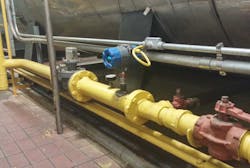Q: Are thermal mass flowmeters affected by changes in the composition of gas, i.e., will they require recalibration every time the composition changes?
A: Thermal mass flowmeters measure a flow rate based on convective heat transfer. One of the many factors that influence convection is fluid composition. Each gas has unique properties, which is why flowmeters are calibrated for a specific application. You would not want a meter calibrated for an air application placed into a natural gas application without recalibration or some type of field adjustment (if applicable).
All gas mixes are not created equal though. If you had a gas mix with high hydrogen content, a variation in hydrogen would have a much greater effect than typical variation in natural gas content. Hydrogen has a tendency to create more heat transfer than most gases. For natural gas, it is common to have some slight variation in composition between the calibration of the device and the application itself. However, the effect is minimal for slight changes in methane or ethane at different times of the year. Natural gas fuel flow is one of the most prevalent applications for thermal mass.
Each application presents unique difficulties for every flowmeter technology. A much greater source of error based on our experience is due to installation. If you do not install a flow meter per the manufacturer’s recommendation, this will greatly influence the performance of the meter. For thermal mass, this includes proper straight run, depth into the pipe (insertion probes) and flow arrow alignment.
There is no exact answer as to when a recalibration would be needed for thermal mass, as the answer is application dependent. However, you do not always need recalibrations for variation in gas composition.
Q: Does a thermal mass flowmeter require temperature compensation during gas flow measurement?
A: Yes, thermal mass flow requires temperature compensation. This is not the same as temperature correction, as you would see with a multivariable transmitter or external flow technologies, such as differential pressure, in order to obtain Nm3/h, SCFM, SCFH, etc. Thermal manufacturers understand that gas properties that effect heat transfer vary with temperature. The process temperature is already being measured (by an RTD) and is accounted for in the calculation.
Q: How does a thermal dispersion mass flowmeter compare to a vortex flowmeter for gas measurement applications (compressed air both wet and dry, nitrogen, natural gas) in terms of advantages and disadvantages?
A: The most common applications for vortex flowmeters are steam and liquid flow measurement. They are also used in high velocity gas flow applications, but there are limitations in terms of the low flows a vortex flowmeter can measure. There needs to be high enough gas flow rates to create vortices around the blunt element in the line, which is the basis of the vortex flow measurement. The flow rates measured by vortex flow meters are actual flow rates, or the flow rate at operating conditions. To convert to standard conditions (mass flow) the user must make a conversion based on measurement of the operating temperature and pressure, or have a flow meter that is integrated with a multivariable transmitter.
By contrast, most thermal flowmeters are used in gas flow applications. Condensed moisture in the line can cause high measurements as the relative cooling of the sensor increases. Thermal flowmeters are often installed at points where condensation is knocked out of the line. Thermal flowmeters have high sensitivity at low flow rates and low pressures, which is a difficult measurement for many other technologies. It is also one of the only technologies that outputs a mass flow, taking away the need for external temperature and pressure measurement.
There are advantages and disadvantages to every flowmeter technology.
Q: Are thermal dispersion flow meters a good fit for natural gas flow measurement applications?
A: Natural gas flow measurement is a popular application for thermal flowmeters. While thermal flowmeters are not an approved custody transfer meter for natural gas, many times they are used to measure natural gas flow to individual combustion sources. There are many advantages to thermal over other technologies. For example, thermal flowmeters have better low flow sensitivity and a higher turndown than traditional flowmeters that utilize differential-pressure technology.
Q: Is the flow unit Nm3/hr considered as mass flow or volumetric flow?
A: Thermal mass flow is always considered a "mass" measurement, as the mass of the gas molecules has a direct influence on the heat transfer created. This is why no temperature or pressure correction is necessary to measure a flow rate at standard temperature and pressure (STP) or at a set of base conditions.
Manufacturers of constant-temperature devices (the vast majority) will perform a calibration to establish the relationship between the power to heat the heated sensor and the "mass velocity"; for example standard feet per minute (SFPM). As convective heat transfer increases with higher flow rates, it takes more power to maintain the constant temperature difference. This SFPM will be multiplied by the area of the pipe as well as other constants and proprietary factors to then output a volumetric form of the measurement, such as Nm3/h, SCFM, SCFH, etc.
Constant power devices will have the opposite operation. The variable temperature difference decreases as the flow rate increases. This method is generally accepted to have a slower response time than constant temperature. As the flow rates vary, the heated sensor has to reach thermal equilibrium to make the measurement.
Have a question about thermal mass flow measurement or flow measurement in general, submit it to Tom using the form below.
This content is sponsored by Magnetrol International. Sponsored content is authorized by the client and does not necessarily reflect the views of the Process Flow Network editorial team.



